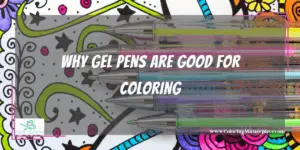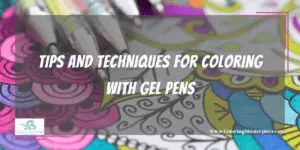Gel pens are gaining popularity in the adult coloring world, but if you haven’t used them before, you might be wondering whether they’re that good for coloring. Gel pens are good for coloring and can be used in a variety of ways, including:
-
- Coloring backgrounds and large areas
- Intricate details and precision work
- Creating shading and shadow effects
- Adding attractive accents and patterns
- Layering and blending
The more you experiment with gel pens, the more you’ll find the best pens and techniques that work with your coloring style. Below, we’ll cover how gel pens differ from other pens, what they’re best used for, and some gel pen techniques you might want to try out.
Why Gel Pens Are Good for Coloring

Gel pens are versatile tools that every colorist should have in their toolbox. Before we get into their uses, it might help to know a little more about the pens. Gel pens work much like ballpoint pens, but instead of quick-drying oil-based ink, water-based gel ink is used. This makes the ink glide effortlessly onto the paper, making gel pens perfect for longer projects and colorists with arthritis and carpal tunnel issues.
Gel ink tends to take longer to dry than ballpoint ink, but some companies like Bic offer quick-drying models. The pigment in gel pens tends to be more vibrant than in rollerball and ballpoint pens and comes in unique variations such as:
-
- Neon
- Metallic
- Glitter
- White (great for highlighting)
Because the ink is a gel, you usually have to worry about gel pens bleeding through the paper you’re using or feathering as many markers do.
Gel pens are portable and don’t require sharpening, making them a convenient coloring tool.
The main drawback to coloring with gel pens is that they need to be replaced pretty often since they go through ink quickly. But they’re relatively inexpensive, so this isn’t a dealbreaker for most people.
Check out the gel pens we recommend here!
What Coloring Projects Are Gel Pens Good For?
Gel pens can be used in any coloring project you’d like, of course, but there are a few things that they’re known to be especially useful for.
Fill in Backgrounds and Large Areas
The smooth ink makes gel pens ideal for filling in large areas such as backgrounds in a short amount of time, mainly if you use some of the techniques we mention a little later, like:
-
-
-
- Cross-hatching
- Stippling
- Color Wash
-
-
Just be sure to work from right to left if you’re left-handed and from left to right if using your right hand. Otherwise, the ink is likely to smear when your hand drags across it.
Use Increased Control for Detailed Work
The fine points of gel pens give colorists a good deal of control, so they’re useful for intricate work and fine details.
The gel ink tends to stay put, too, rather than soaking into the page and feathering out across lines.
Make the Most of Layering
Gel pens are great for layering, either with other gel pens or other art mediums. Take advantage of fun varieties like metallic and glitter pens and experiment with different layering effects.
Create Shading and Shadow Effects
The precision of gel pens coupled with their intensely pigmented ink allows them to be used on top of other mediums like colored pencils to create shadows and shading, which will add more depth and dimension to your coloring.
Add Interest to Your Work
Gel pens can be used to add texture and patterns to your work, like:
-
-
-
- Contouring
- Polka dots
- Abstract Shapes
- Swirls
-
-
Half the fun of coloring is adding to what’s been given to you on the page to make it your own. Don’t be afraid to have fun with it and add a pattern or accent to a drawing.
Tips and Techniques for Coloring With Gel Pens

Many colorists are surprised when they discover just how much you can do with a gel pen. Here are some ideas to get you started on your gel pen journey.
Take Your Blending to the Next Level
Because gel ink usually takes a while to dry, it’s perfect for blending. Be sure to blend while the ink’s wet because once it dries, it’s pretty much set. Some colorists have the best luck by blending different brands, one with a “wetter” ink, and one whose ink is “drier.” Use the wetter ink for the first layer, and swirl the second ink to make cool marbled effects.
Make sure to experiment with gel pen blending on scratch paper before using it on a piece of art you’d like to keep since it can take a little while to get the hang of. To prevent your work from turning into a giant smear when you try to blend, try keeping a paper towel and a cotton swab or small cosmetic sponge on hand to keep pen tips and blending tools clean as you work.
Faded Ink Effects for Backgrounds and Shading
Make a thick line of color with your gel pen, then drag a dry or damp paintbrush, sponge, or cotton swab through it while it’s still wet. This will pull the ink away from the line, fading as it gets further away. This can be used to add depth with shading and contouring or just for cool background effects.
Color Washes Aren’t Just for Watercolors
Achieve an almost watercolor effect by going over wet gel ink with a wet paintbrush, thin and distributing the ink for a color-washed effect. This technique works great for covering large areas and backgrounds but can result in the paper getting damaged by the water and curling or wrinkling. Because of this, make sure to use as little water as possible, and also opt for thicker paper or cardstock if you can.
Fill in Backgrounds Quickly With Cross-hatching
Hatching is just a fancy way of saying parallel stripes, and cross-hatching means two sets of stripes “crossing” each other. This technique can be done with colored pencils and markers, but the bold, clear lines of gel pens pop. Cross-hatching is perfect for covering a large area quickly and is especially useful for creating texture when coloring in curtains and upholstery.
The closer together the lines are, the darker the area will look, and the further apart, the lighter. You can play around to create the illusion of depth by using closely spaced lines around the perimeter and spacing them further as you reach the center and vice versa.
Stippling Adds Texture and Dimension to Large Areas
Stippling is another unnecessarily fancy word for something basic: coloring with dots. Instead of using strokes of the pen to lay down an even layer of color, stippling involves making groups of dots to fill in areas. Stippling can be used in much the same way as stippling, with more closely packed dots creating a darker and deeper-seeming area and sparser dots making the area seem lighter and more highlighted.
This technique works in many situations, but landscapes and nature scenes lend themselves exceptionally well to the pattern.
Gel Pens in Mixed Media Works
Gel pens are ideal for use in mixed media works for many reasons:
-
-
-
- Their vibrant ink compliments softer mediums like pencil and watercolor
- Their fine point allows for precise additions.
- The gel ink tends not to soak in, making it perfect for layering.
- The wide array of colors available ensures that you’ll find a pen to match any work.
-
-
Do Rubbings Over a Textured Surface
Many colorists might remember this technique from their school days: art rubbings. This involves laying the artwork on top of a textured surface and rubbing pen, pencil, or charcoal over it. The medium will pick up the surface’s texture through the paper, making a unique effect on the artwork. Gel pens are great for this since their ink is so fluid that you can get a lot of detail without pressing very hard. Plus, you don’t have to worry about wearing down the point.
Some fun surfaces for art rubbings are:
-
-
-
- Cement
- Leaves
- Uneven wood surfaces
- Tiles
- Window screens
-
-
Final Thoughts
Gel pens are convenient, versatile, and inexpensive options for coloring a variety of styles. Even if you’re not a pen person when it comes to coloring, they’re worth trying out at least once. After all, the more mediums you familiarize yourself with, the more tools you’ll have at your disposal when it comes to making unique art.
Frequently Asked Questions
What papers do gel pens work best on?
Gel pens are versatile art tools and can be used on just about any paper or cardstock. Translucent ones work best on light-colored paper, but the metallic and glitter variety can be used on light and dark papers.
How can I revive an old gel pen?
Dried-up gel pens can be revived by adding a little water to the ink tube and shaking it to thin the ink out. If this doesn’t work, soak the pen tip in warm water to remove any ink clumped in the tip.
Let’s try it out! Click here to download my free adult coloring eBook and sign up for my email newsletter!
Disclaimer: The information provided by ColoringMasterpiece.com (“The Site”) is for general informational purposes only. All information on the Site is provided in good faith, however, we make no representation or warranty of any kind, express or implied, regarding the accuracy, adequacy, validity, reliability, availability, or completeness of any information on the Site. Under no circumstance shall we have any liability to you for any loss or damage of any kind incurred as a result of the use of the Site or Reliance on any information provided on the Site. Your use of the Site and your reliance on any information on the Site is solely at your own risk. This blog post is for educational purposes only and does not constitute legal advice. Please consult a legal expert to address your specific needs.
Terms and Conditions: https://coloringmasterpiece.com/terms-and-conditions/
